Game Review—Fallout: Shelter
You don’t give me love, you give me pale shelter.
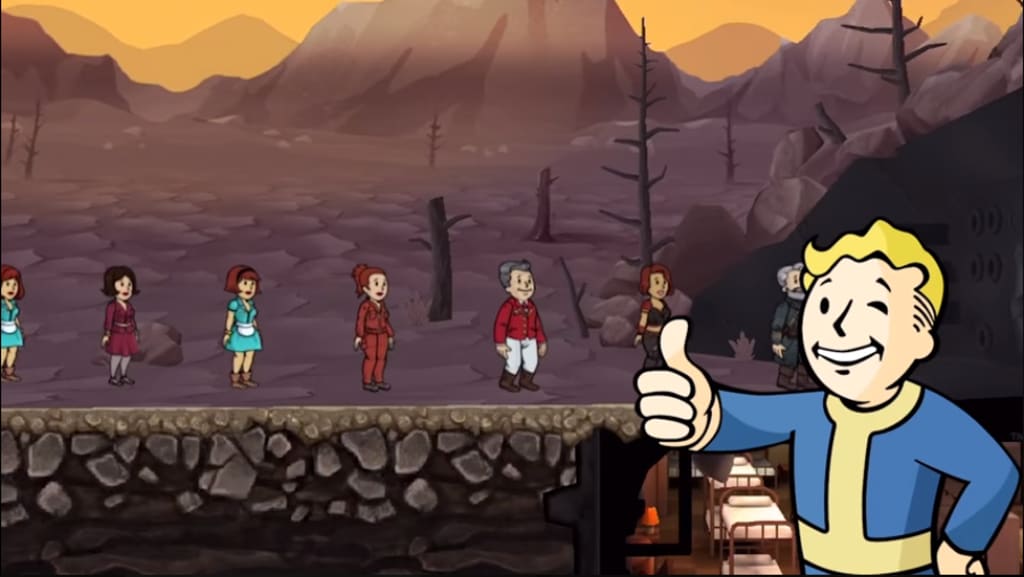
In 2077, nuclear bombs rained down on America, destroying cities and making the earth uninhabitable. The only safe place was underground, inside the vaults constructed by Vault-Tec. But safety proved to be relative, with the vaults posing their own unique dangers, including the sinister experiments carried out by the Vault-Tec corporation. No-one knew they were signing up for that, but it’s a better fate than dying of radiation sickness outside, or slowly turning into a feral ghoul.
You are the overseer of one of these vaults (although you can run three in parallel if you like), with the aim of “creating a brighter future underground”. I guess that things will probably start to glow, at least. You’re working within a 2D environment cutting a cross-section through the rooms of your vault. You must assign workers to the appropriate rooms to generate resources, and you can send dwellers out into the wasteland on quests and to scavenge.
Fallout: Shelter was created as a promotional tool for Fallout 4, but I didn’t really see many similarities or crossovers between this game and Fallout 4 at the time. But within Fallout 76 (which I’m currently hooked on), there are references that I notice. I've since realised that some of Fallout 4's characters are reproduced in Fallout: Shelter, but that's another game I've not completed yet. Both 4 and 76 have incorporated a building element, which isn’t compulsory but opens up a load of new options and ways to play the game. All of them continually reinforce the point that life after the nuclear apocalypse is bleak and fragile.
While the full games will set you back anywhere between £20 and £55 depending on platform and version, Fallout: Shelter is 100% free. Apart from the freemium content, that is – but unlike other games using the freemium model, Fallout: Shelter is playable without any financial investment. You might end up paying because you want more content, but not because you need it in order to continue playing.
I downloaded Fallout: Shelter as soon as it was available, and I vaguely remember linking my Fallout 4 experience to the Fallout app on my phone, so that it could act as a Pip-Boy (the 22nd Century version of the Filofax). It was kinda cool, but not what I installed it for. I wanted to be able to play Fallout: Shelter on my phone, and it’s surprisingly do-able, even with established vaults that would require scrolling and zooming on a PC monitor. The user experience is of equally high quality across devices, and the intermittent nature of play suits portable devices well.
Your vault and its dwellers are in the cartoon style of Vault Boy, and there’s a great deal of interchangeability between characters, rooms and outfits. It reduces the effort and cost of design, but still allows enough permutations to remain interesting and allow enough difference between dwellers and across the vault structure. The game is made of simple building blocks, and it is your strategy that brings the complexity and hopeful victory to the vault.
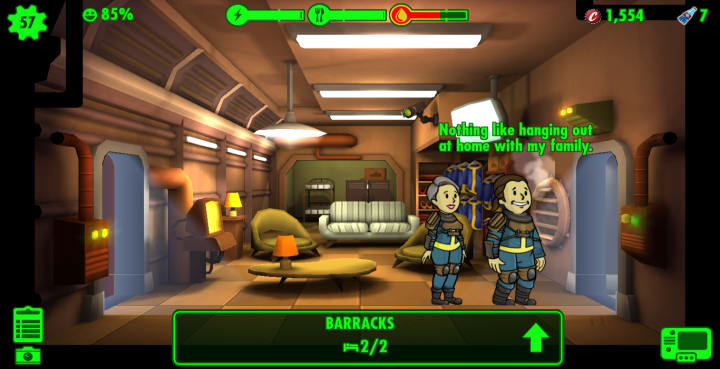
Things will be sent to try you: infestations, raiders, dangerous creatures and the effects of radiation. You must adapt to keep your dwellers alive and build resilience against attacks from the wild and within the very earth you’ve built into. There are two modes: regular and survival mode – with the latter increasing the frequency of hostile events and reducing your dwellers overall health and ability to deal with the onslaught of bad stuff that living underground in irradiated bedrock brings. But sometimes a challenge can be fun!
Fallout: Shelter is definitely one of those games where losing is fun. As far as I can tell, there’s no way of “winning”; you just keep your vault going for as long as you can. If you get too good at it, which you will if you’ve been playing it as long as I have, then you can invest in your vault and apply a little self-improvement to your dwellers. I like to see how many I can get to Level 50 and with maximum S.P.E.C.I.A.L. attributes. And if your vault is boringly successful, you can just delete it and start all over again. Like the Kingdom games, which I reviewed here, here, and here; there is a lot more excitement in the early stages of the game, when you’re starting from nothing. An established vault, with at least 30 dwellers, tends to run itself (until the deathclaws arrive). Even though you need higher numbers of dwellers to unlock certain features, it feels like most of the fun is had before your vault expands to that extent.
But of course, this doesn’t make the game unplayable or ‘bad’, it’s just that the initial rapid development stage holds the most excitement and challenge. This effect is emphasised when in survival mode, as you will need to fight more fires (literally and figuratively) while trying to gain resources to feed your dwellers and create enough space to house them and exploit their skills. 2077’s nuclear war was driven by ruthless capitalism, and you’ll be making the same mistakes all over again as human beings are treated like cogs in a machine to extract as much value as possible. But it’s the only system we know, apparently.
As well as the cheapness of human life and the only value being in human labour, the game has some serious issues with gender roles – although it’s fair to say that both sexes are getting screwed by the world we have created post-2077, just in different ways. One of my friends used to refer to this game as “build your own patriarchy” and they have a point. There are many dweller capabilities that are dependent on gender, in addition to those which transcend sex, and those which can be improved for all dwellers.
One of the easiest ways to improve a dweller’s S.P.E.C.I.A.L. skills is to put on an outfit. Most outfits can be worn by any dweller (fortunately they all wear the same size), but some are gender-specific. Only men can be knights and medieval rulers, but only women can be engineers and surgeons. Good thing they put us ladies in charge of the important stuff. But it’s pregnancy that has the greatest effect on gender divisions. If a female dweller isn’t pregnant, she can do all the things that male dwellers can do. But it’s different for pregnant dwellers and children.
For a start, there’s some real Nice Guy logic in the Fallout: Shelter dating scene. Dwellers don’t choose their own partners, they are selected by you and reproduce by being placed in the same Living Quarters as a member of the opposite sex. In this world, sex is binary, but I have no idea how the dwellers might identify. There’s also no mention of same-sex relationships, but given this game is basically a human farm, there’s not much room for equal rights. Each couple’s combined Charisma score is what governs the speed of their relationship. High scores and they’ll be jumping straight in the sack, lower scores and they’ll be making small talk for hours (look, in the Fallout world, time is speeded up, OK?). Attraction is irrelevant; time and effort is what gets the job done.
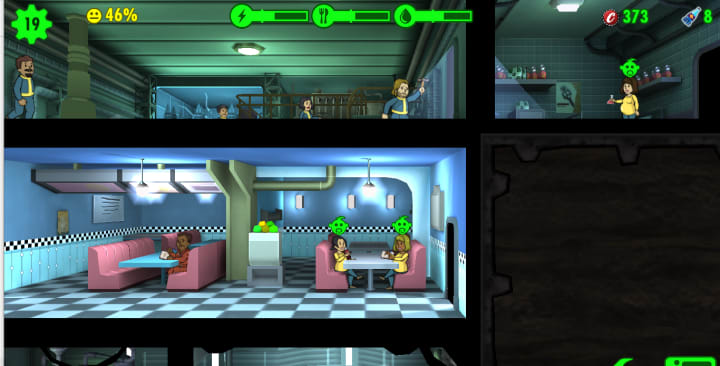
Following impregnation, dwellers aren’t too bothered about their partner having other loves. All children are brought up communally, with three hours needed to mature to adulthood (the same duration as a pregnancy). One thing they will not indulge in, however, is incest – although I’ve not tested the limits of this. Are cousin marriages OK? I’m not sure (I may report back). This free-love bonanza happens because it’s just too easy for dwellers to die. The replacement level of a vault dwelling woman must be at least 8 children. And if you run out of dwellers, then you die. Better get busy.
In the event of an attack or internal disaster within the vault, pregnant ladies and children become immortal – I’ve not once killed off a child or incubating human, and goodness knows I should have with the utter wrecks I’ve turned vaults into. Whenever things kick off in the vault, pregnant women and kids run off and hide, leaving the menfolk and any non-pregnant women to defend the vault and clean up the mess. So while vault women have to live through the ordeal and inconvenience of near-constant pregnancy, they do at least adopt a temporary invincibility. But let’s not pretend death is not a very real part of vault life. Because it is.
Have you ever looked back over your family tree and seen the absurd number of children people were having before your great-grandparents’ generation? What about Victorian death photography? You know about that? At the same time, the UK was undergoing huge change in the Industrial Revolution, and inequality was widening. People needed more children than they have nowadays because their kids kept dying of preventable illnesses, and they needed more family members to contribute their meagre wages to the household, and eventually look after the parents in old age. Fallout is just like the 19th Century, except you don’t get to live to old age.
As the vault overseer, your decisions are life-or-death choices. Some of your dwellers aren’t going to make it, and you’ll have to learn to live with that. Harsh conditions make for unfair outcomes, no matter how hard you try to mitigate. Take a look at the abandoned vaults we discover in the wasteland in the full Fallout games, and there’s a story that explains just what went wrong in every case. But can you learn from their mistakes? Or maybe you’ll choose to replicate them. Like in any game of the Fallout series, you can choose to be good, bad or indifferent. Sometimes survival is a dirty game, and someone needs to play it.
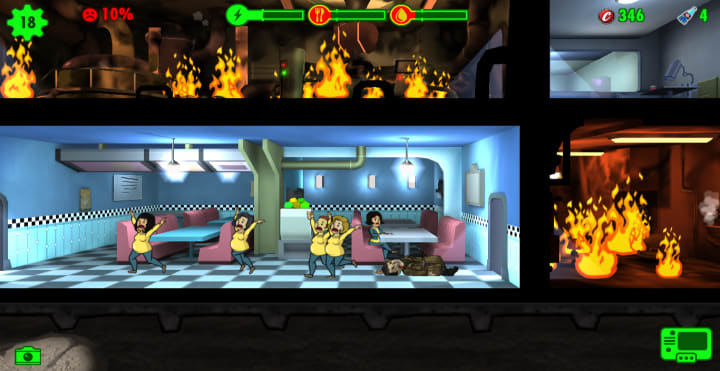
Fallout: Shelter is available on iOS, Android, PC, Nintendo Switch, Xbox One & PS4.
About the Creator
Katy Preen
Research scientist, author & artist based in Manchester, UK. Strident feminist, SJW, proudly working-class.
Enjoyed the story? Support the Creator.
Subscribe for free to receive all their stories in your feed. You could also pledge your support or give them a one-off tip, letting them know you appreciate their work.


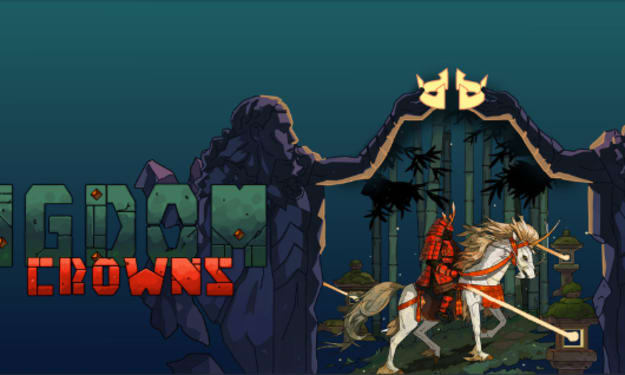



Comments
There are no comments for this story
Be the first to respond and start the conversation.